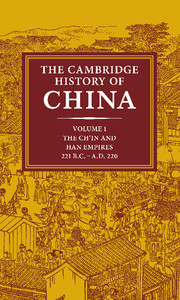Book contents
- Frontmatter
- Introduction
- 1 The state and empire of Ch'in
- 2 The Former Han dynasty
- 3 Wang Mang, the restoration of the Han dynasty, and Later Han
- 4 The conduct of government and the issues at stake A.D. 57–167
- 5 The fall of Han
- 6 Han foreign relations
- 7 The structure and practice of government
- 8 The institutions of Later Han
- 9 Ch'in and Han law
- 10 The economic and social history of Former Han
- 11 The economic and social history of Later Han
- 12 The religious and intellectual background
- 13 The concept of sovereignty
- 14 The development of the Confucian schools
- 15 Confucian, Legalist, and Taoist thought in Later Han
- 16 Philosophy and religion from Han to Sui
- Postscript to Chapter 16
- Bibliography
- Glossary-Index
- Map 7 The Han empire, 143 b.c.
- Map 8 The Han empire, 108 b.c
- Map 9 The Han empire, a.d. 2
- Map 12 The Han empire, a.d. 140">
- References
Postscript to Chapter 16
from 16 - Philosophy and religion from Han to Sui
Published online by Cambridge University Press: 28 March 2008
- Frontmatter
- Introduction
- 1 The state and empire of Ch'in
- 2 The Former Han dynasty
- 3 Wang Mang, the restoration of the Han dynasty, and Later Han
- 4 The conduct of government and the issues at stake A.D. 57–167
- 5 The fall of Han
- 6 Han foreign relations
- 7 The structure and practice of government
- 8 The institutions of Later Han
- 9 Ch'in and Han law
- 10 The economic and social history of Former Han
- 11 The economic and social history of Later Han
- 12 The religious and intellectual background
- 13 The concept of sovereignty
- 14 The development of the Confucian schools
- 15 Confucian, Legalist, and Taoist thought in Later Han
- 16 Philosophy and religion from Han to Sui
- Postscript to Chapter 16
- Bibliography
- Glossary-Index
- Map 7 The Han empire, 143 b.c.
- Map 8 The Han empire, 108 b.c
- Map 9 The Han empire, a.d. 2
- Map 12 The Han empire, a.d. 140">
- References
Summary
The survey of developments in Chinese philosophy and religion between Han and T'ang contained in this chapter constitutes one of the last major publications of Paul Demiéville (1894–1979) in a career that stretched from the days of Chavannes and Pelliot to the more recent efflorescence in Paris of the study of Chinese religion. The breadth of learning revealed here is typical of Demiéville's scholarship, and though written in the early 1970s, this chapter still stands as a masterly summary of the intellectual history of the period ten years later.
Inevitably, however, our understanding of certain aspects of the topics treated in this chapter has changed in the course of time. Remarkably, Demiéville's treatment of the development of Chinese Buddhism and its relations with the Chinese philosophical tradition (a subject on which he was an acknowledged authority) does not warrant any major qualification, although it is clear that new areas of research are being opened up that may one day give us a picture of how Buddhism was understood not only by the few who possessed philosophical inclinations, but also by the many who cared little for doctrinal subtlety. In the case of Taoism some futher comment on his remarks is already necessary.
One of the principal concomitants of the rapid advances that are now being made in our understanding of Taoism has been an increased self-consciousness about the application of the label Taoist. In the early 1980s scholars are much more chary of dealing out this label than hitherto, especially since it has been recognized that historically the Chinese, though not always as precise in their terminology as one might wish, had a much more clearly focused conception of who was a Taoist and who was not than many modern Western sinologists.
- Type
- Chapter
- Information
- The Cambridge History of China , pp. 873 - 878Publisher: Cambridge University PressPrint publication year: 1986



